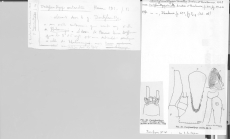WoRMS name details
Dactylamblyops tenella Birstein & Tchindonova, 1958
227030 (urn:lsid:marinespecies.org:taxname:227030)
unaccepted > incorrect grammatical agreement of specific epithet
Species
marine, fresh, terrestrial
Birstein, J.A. & Tchindonova, J.G. (1958). Glubokovodnye mizidy severo-zapadnoi chasti Tikhogo Okeana (Deep-sea mysids of the northwest Pacific Ocean). <em>Trudy Instituta Okeanologii AN SSSr.</em> 27: 258-355. [details] Available for editors  [request]
[request]
Taxonomic remark Email from Karl Wittmann to Jan Mees dd 8-9-2015: Many species names of Erythropinae are badly spelled. In those cases...
Taxonomic remark Email from Karl Wittmann to Jan Mees dd 8-9-2015: Many species names of Erythropinae are badly spelled. In those cases where the genus name ends with "-ops" and the species name is an adjective, the name has to be transferred from female to male gender. [details]
Mees, J.; Meland, K. (Eds) (2012 onwards). World List of Lophogastrida, Stygiomysida and Mysida. Dactylamblyops tenella Birstein & Tchindonova, 1958. Accessed through: World Register of Marine Species at: https://www.marinespecies.org/aphia.php?p=taxdetails&id=227030 on 2024-11-09
Date
action
by
2006-05-10 15:31:07Z
created
db_admin
![]() The webpage text is licensed under a Creative Commons Attribution 4.0 License
The webpage text is licensed under a Creative Commons Attribution 4.0 License
original description
Birstein, J.A. & Tchindonova, J.G. (1958). Glubokovodnye mizidy severo-zapadnoi chasti Tikhogo Okeana (Deep-sea mysids of the northwest Pacific Ocean). <em>Trudy Instituta Okeanologii AN SSSr.</em> 27: 258-355. [details] Available for editors  [request]
[request]
basis of record Various Authors (2000). Nematode filing cabinet of the Marine Biology Section Ugent - in combination with the NemasLan Ms-Access database (published on CD-Rom, 2000) (look up in IMIS) [details]
additional source Müller, H. G. (1993). World catalogue and bibliography of the recent Mysidacea. 238p. [details] Available for editors [request]
[request]
additional source Bacescu, M. (1971). <i>Mysimenzies hadalis</i> g.n. sp.n., a benthic mysid of the Peru Trench, found during cruise XI/1965 of R/V Anton Bruun (U.S.A.). <em>Rev. Roum. Biol.-Zool.</em> 16 (1): 3-8. [details] Available for editors [request]
[request]
additional source Birstein, J.A. & Tchindonova, J.G. (1958). Glubokovodnye mizidy severo-zapadnoi chasti Tikhogo Okeana (Deep-sea mysids of the northwest Pacific Ocean). <em>Trudy Instituta Okeanologii AN SSSr.</em> 27: 258-355. [details] Available for editors [request]
[request]
additional source Wooldridge, T. H.; Mees, J. (2011 onwards). World List of the Mysidacea. [details]
additional source Zharkova, I.S. 1970. Reduction of the organs of vision in deep-sea mysids.-- Zoologicheskii Zhurnal 49: 685-693. [details] Available for editors [request]
[request]
basis of record Various Authors (2000). Nematode filing cabinet of the Marine Biology Section Ugent - in combination with the NemasLan Ms-Access database (published on CD-Rom, 2000) (look up in IMIS) [details]
additional source Müller, H. G. (1993). World catalogue and bibliography of the recent Mysidacea. 238p. [details] Available for editors
additional source Bacescu, M. (1971). <i>Mysimenzies hadalis</i> g.n. sp.n., a benthic mysid of the Peru Trench, found during cruise XI/1965 of R/V Anton Bruun (U.S.A.). <em>Rev. Roum. Biol.-Zool.</em> 16 (1): 3-8. [details] Available for editors
additional source Birstein, J.A. & Tchindonova, J.G. (1958). Glubokovodnye mizidy severo-zapadnoi chasti Tikhogo Okeana (Deep-sea mysids of the northwest Pacific Ocean). <em>Trudy Instituta Okeanologii AN SSSr.</em> 27: 258-355. [details] Available for editors
additional source Wooldridge, T. H.; Mees, J. (2011 onwards). World List of the Mysidacea. [details]
additional source Zharkova, I.S. 1970. Reduction of the organs of vision in deep-sea mysids.-- Zoologicheskii Zhurnal 49: 685-693. [details] Available for editors
 Present
Present  Present in aphia/obis/gbif/idigbio
Present in aphia/obis/gbif/idigbio  Inaccurate
Inaccurate  Introduced: alien
Introduced: alien  Containing type locality
Containing type locality
From editor or global species database
Habitat mesopelagic [details]Taxonomic remark Email from Karl Wittmann to Jan Mees dd 8-9-2015: Many species names of Erythropinae are badly spelled. In those cases where the genus name ends with "-ops" and the species name is an adjective, the name has to be transferred from female to male gender. [details]

